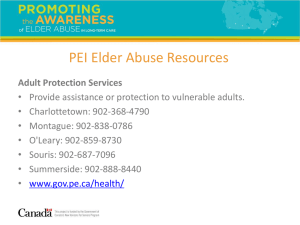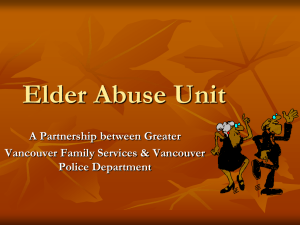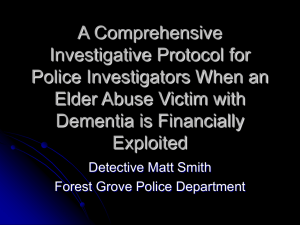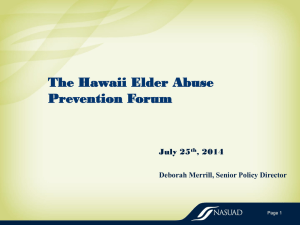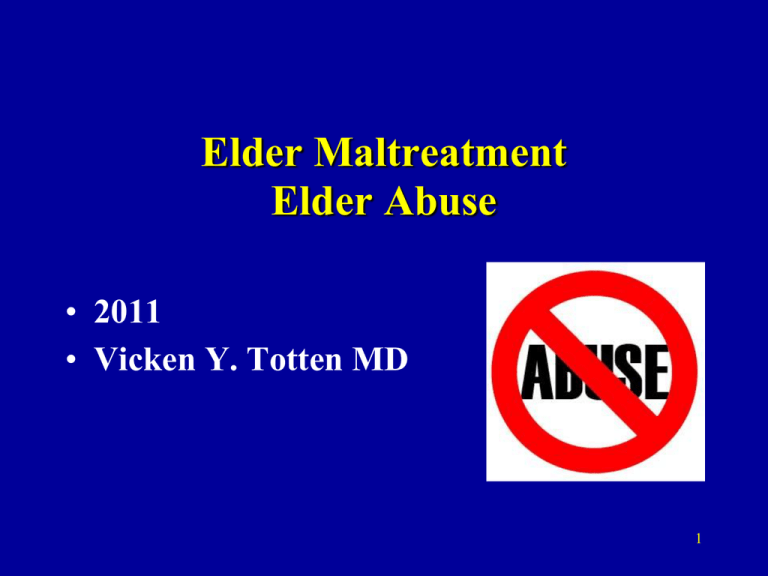
Elder Maltreatment
Elder Abuse
• 2011
• Vicken Y. Totten MD
1
AMA Definition of Elder Abuse
“… an act or omission which results in harm or
threatened harm to the health or welfare of an
elderly person. Abuse includes intentional
affliction of physical or medical injury; sexual
abuse; or withholding of necessary food,
clothing, and medical care to meet the physical
and mental needs of an elderly person by one
having the care, custody, or responsibility of an
elderly person”
2
Legal Definition
• The law defines elder abuse as "physical abuse, neglect,
financial abuse, abandonment, isolation, abduction or
other treatment with resulting in physical harm or pain
or mental suffering, or the deprivation by a care
custodian of goods or services that are necessary to
avoid physical harm or mental suffering." (Welfare &
Institutions Code, Section 15610.07 and in Penal Code
368) "Elders" are defined as persons 65 years of age or
older.
3
Exploitation is a form of abuse
• Resources
• Financial
• Sexual
4
Types of Elder Maltreatment
• Physical Abuse: Violence to person
• Sexual Abuse: Sexual use solely for another’s
gratification
• Physical Neglect: Failing to provide a safe environment,
clean water, sufficient food and medications
• Psychological Abuse or Neglect: Failing to provide for
the social / psychological needs of the elder
• Material Exploitation or Neglect: Failing to use the
elder’s resources for the elders benefit
5
Physical Abuse:
• Assault, battery,
• sexual assault, battery or rape,
• prolonged or continual deprivation of food or
water, or medications
• use of physical or chemical restraints for
punishment, convenience or without or beyond
the scope of the doctor's order.
6
Physical Abuse
•
•
•
•
Pushing, shoving, slapping
“he steps on my feet”
Visible and non-visible
Discovery depends on entertaining the
dx.
• More common in the helpless
7
Sexual Abuse
• Oral, Anal, vaginal, rectal, stomal
• A source of post-menopausal vaginal
bleeding
• “My son-in-law needs me”
• Sexual predators get old too.
• Happens in nursing homes. Not all sexual
congress in the elderly is abuse
8
Neglect:
• The failure to exercise that degree of care that
a reasonable person in a care providing
capacity would exercise such as failure to assist
in personal hygiene, provision of food, clothing
or shelter, provision of medical care, or to
protect from health and safety hazards or to
prevent malnutrition or dehydration.
Note: This includes self-neglect; one of the
most common forms of abuse occurring in
community settings.
9
Falls
10
Physical Neglect
• Failing to provide, or deliberately
withholding necessities:
• Hearing aid, eyeglasses, walker, cane,
wheelchair, medications
• Food, help in bathing, clean clothes
• Failure to provide appropriate physical
precautions
11
Psychological Abuse or Neglect
• Threats of deprivation or harm
• “Nobody else wants you, you are useless.
You should be grateful I even do…”
• Failure to provide transportation
• Failure to permit access to social contacts
12
Financial Abuse:
• The illegal or unauthorized taking or
using of an elder's funds, property or
assets by an individual or entity.
13
Control over finances
14
Material exploitation or
Neglect
• Theft of money, possessions
• Keeping the elder for their social security
check
• Getting power of financial attorney
• Preying on the elder’s gullibility,
helplessness, or ignorance
15
Mental Suffering:
• Causing fear, agitation, confusion, severe
depression or other forms of emotional
distress that is brought about by threats,
harassment, or other forms of
intimidating behavior.
• (Legal definition)
16
PSYCHOLOGICAL ABUSE
•
•
•
•
•
Threats – of violence, of abandonment
Insults
Harassment
Belittlement
Retaliation
17
Threats and intimidation
18
Isolation:
• The
intentional
preventing or
restraining an
elder from
receiving mail,
telephone calls
or visitors.
19
Scope of the problem
20
EPIDEMIOLOGY
• 1-5% of elderly are victims of abuse
• Others cite larger numbers
21
CAUSES (often in combination)
• Physical dependency
• Caregiver stress
- 36-hour day, frustration, lack of finances,
lack of employment
- often combined with a triggering event
- treatment = relieve the stress if possible
• Supervision, continued
22
CAUSES (continued)
• Family violence pattern
Abused children become abusive adults
who then abuse own children and also
their parents (treatment often to separate
them).
• Pathological abuser
- Drugs and alcohol abuse
- Mental illness
- Treatment = separation
23
Factors that increase Risks of
Elder Maltreatment
• Victim Factors
• Caregiver Factors
• Environmental /
System Factors
• A permission microenvironment
24
Screening and Assessment for
Elder maltreatment
• Similar to screening for domestic violence
– Use open-ended questions
• How do you feel about your safety at home?
• Who helps you at home?
– How is this working out for you?
• What happens when there are disagreements at
home?
• How are financial decisions made?
• Do you get out of your home very much?
• Who else do you see/talk to besides (caregiver)?
25
THE TYPICAL VICTIM
•
•
•
•
•
Widow > 70 years old
insufficient income to live independently
increasing dependency
cognitive impairment, especially if recent
more problem behaviours: shouting,
incontinence, wandering, paranoia,
stubborn, critical
26
Victim Factors:
– Elder’s cognitive impairment
• Dementia – less able to protect self
• Elder gets abusive, violent, socially
inappropriate
– Poor health - > Elder requires much
care
– Social isolation of both the care give
and the elder
27
Caregiver
Factors:
• History of
violence, or
victim of abuse
• Substance abuse
• External
stressors
28
The typical abuser – a relative
40%
of time spouse / 50% child or
grandchild
In
relationship with victim for average of 9.5
years
Under stress:
alcohol or drugs
marital problems
social isolation
employment and or financial difficulties
29
The abusive child of the elder
Often
least socially integrated child
(the well functioning children have left
the home)
May be from family where violence is
norm.
“payback”
30
Environmental/System Factors:
• Victim and perpetrator in shared living
situation
• Financial and other dependence on
caregiver
• Perpetrator financially dependent on the
elder
31
Warning signs
•
•
•
•
•
•
•
•
•
Abuser Often speaks for elder
Abuser isolates elder
Abuser controls mail, visits and phone calls
Elder appears helpless, confused, hesitant to speak freely
Elder has insufficient food and basic necessities
Elder exhibits poor hygiene
Untreated medical conditions
Visible injuries
Change in sleep, appetite or behavior
32
DIAGNOSIS
• Signs of physical injury
• Conflicting and/or vague histories from the
patient and caregiver
• History inappropriate to degree of injury
• Denial
• Long delay between injury and presentation
• History of being “accident prone”
33
Look For Changes
And/or Extremes:
•
•
•
•
•
•
Unkempt appearance
Emaciated or bloated appearance
Dirty or inappropriate clothing
Unshaven face
Uncombed hair
Unusual or extreme body odors
34
Bruises not consistent with
history
35
Physical Findings
• Welts, laceration, fractures
• Excess drugs / AMS / unexplained
lethargy
• Burns, Bruises
• Lack of clothes, heat, medication, food,
water
• Sometimes frequent falls. “Who helped
you to fall?”
36
On examination
• injuries at different stages of resolution
• bruises in the shape of weapons
• injuries in places normally covered by
clothes or around mouth, face, eyes
• alopecia and haemorrhage under scalp
may indicate hair pulling
• bruises, burns, bite-marks.
37
Examination - continued
• Physical neglect (much more common)
- pallor, wasting, dehydration, decubitus
ulcers. Note that these may also occur in
non-abused elderly.
• Psychological abuse - paranoia, infantile,
depressed, withdrawn, agitated.
38
Hurdles
• Mental health
(competency issues)
• Physical health &
disability/ willingness to
testify –
• Mistrust of others
39
Fear
• Fear of losing loved
one
• Fear of the unknown
• Fear of being alone
• Fear of losing living
essentials
40
Legal problems of intervening
• When neither the victim nor the abuser is cooperative, may need guardianship
• No provision for mandatory reporting (as for
child abuse) in many places
• No legal protection for doctors against libel.
41
Intervention
• Talk to victim privately
• If danger suspected, admit person with a
“medical diagnosis”
• Counsel caregiver
- provide information about pt’s condition
- meet needs of caregiver (relieve stress)
- talk to caregiver about how to respond to
patient’s behavioural problems
42
Intervention (continued)
• Respite or alternative care if burden too
great for caregiver
• Help the caregiver maximise the elderly
individual’s abilities.
43
Tips for Caregivers
• Answering "yes" to just one of these questions
could indicate that you need some assistance in
your care giving role. Consider some of the
following avenues.
• Seek out a support group for caregivers.
• Consider hiring support services-a home health
aide, chore worker, or homemaker.
• Enlist the help of family and friends; be specific
in what help you need (e.g., "Could you come
over for two hours on Saturday morning while
I run some errands?").
44
More tips
• Look into available respite care in your
community.
• Make an honest effort to give yourself needed
time to relax, exercise, and eat right.
• Look to community resources for support.
Start with the Area Agency on Aging for your
area or call the Eldercare Locator.
• Consider a Daily Money Management Program45
Management of
Elder
Maltreatment
• Most states have
mandatory
reporting for
suspected elder
abuse
– American Medical
Association
Guidelines
• Elder Abuse and
Neglect
46
Prevention
• Avoid isolation
• Stay social/active – volunteer, see friends
• Avoid living with a person with a history of
abuse or violence
• Beware of family members with financial
motivations or with substance abuse issues
• Consider respite services to relieve caregivers
• Have friends and relatives remain involved and
observant
• Consider Counseling
• Communicate
• Have relatives and friends visit at various times
of the day – unannounced
47
Resources
• In an emergency dial 911
• American Association of Daily Money
Management Program www.aadmm.com
• www.AARP.org
• www.Eldercare.gov {Eldercare Locator}
• Administration on Aging (AOA)
www.aoa.gov/eldfam/Elder Rights/Elder
Abuse/Elder Abuse.asp
48
More resources
• National Center on Elder Abuse (NCEA):
www.elderabusecenter.org
• National Committee for the Prevention of
Elder Abuse: www.preventelderabuse.org
• National Consumer League (NCL):
www.nclnet.org
• http://fraud.org/
• National Long-term Care Ombudsman
Resource Center:
• www.ltcombudsman.org/static
pagesombudsmen.cfm
49
References
• Cline, Ma, Tintinalli, Kelen, Stapczynaki
(2001). Just the facts in Emergency
Medicine. ISBN: 0-07-134549-3
• Goldman, Wise, Brody, (1998).
Psychiatry for Primary Care Physicians.
ISBN: 0-89970-892-7
50
References
• National Women’s Health Information Center,
US Department of Health and Human Services,
Office of Women’s Health
URL:http://www.4woman.gov/violence
http://www.seniorcitizensguide.com/clevela
nd/index.htm
51
Why a
man
needs 3
wives
52

